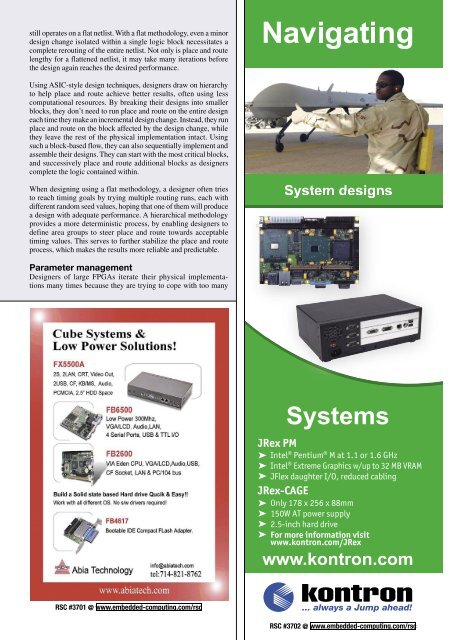Embedded Computing Design - OpenSystems Media
Embedded Computing Design - OpenSystems Media
Embedded Computing Design - OpenSystems Media
Create successful ePaper yourself
Turn your PDF publications into a flip-book with our unique Google optimized e-Paper software.
still operates on a flat netlist. With a flat methodology, even a minor<br />
design change isolated within a single logic block necessitates a<br />
complete rerouting of the entire netlist. Not only is place and route<br />
lengthy for a flattened netlist, it may take many iterations before<br />
the design again reaches the desired performance.<br />
Using ASIC-style design techniques, designers draw on hierarchy<br />
to help place and route achieve better results, often using less<br />
computational resources. By breaking their designs into smaller<br />
blocks, they don’t need to run place and route on the entire design<br />
each time they make an incremental design change. Instead, they run<br />
place and route on the block affected by the design change, while<br />
they leave the rest of the physical implementation intact. Using<br />
such a block-based flow, they can also sequentially implement and<br />
assemble their designs. They can start with the most critical blocks,<br />
and successively place and route additional blocks as designers<br />
complete the logic contained within.<br />
When designing using a flat methodology, a designer often tries<br />
to reach timing goals by trying multiple routing runs, each with<br />
different random seed values, hoping that one of them will produce<br />
a design with adequate performance. A hierarchical methodology<br />
provides a more deterministic process, by enabling designers to<br />
define area groups to steer place and route towards acceptable<br />
timing values. This serves to further stabilize the place and route<br />
process, which makes the results more reliable and predictable.<br />
Parameter management<br />
<strong>Design</strong>ers of large FPGAs iterate their physical implementations<br />
many times because they are trying to cope with too many<br />
RSC #3701 @ www.embedded-computing.com/rsc<br />
RSC #3702 @ <strong>Embedded</strong> www.embedded-computing.com/rsc<br />
<strong>Computing</strong> <strong>Design</strong> Summer 2004 / 37
















